Parameters Window |
  
|
To open property window use the command:
Icon |
Ribbon |
|---|---|
|
View > Window > Tool Windows > Parameters Get Started > Options > Tool Windows > Parameters
|
Keyboard |
Textual Menu |
<Alt>+<4> |
Customize > Tool Windows > Parameters |
The parameters window is used in most commands for creating drawing elements, 3D construction elements and operations to set the parameters of the created or edited object. By default, on the left side of the screen, there is a window that combines the system windows Parameters, Library Explorer and 3D Model. Switching between windows is carried out using the tabs of the same name. If necessary, any window can be positioned anywhere on the screen. To do this, press the right mouse button inside the window, select the Set floating command from the context menu, and then drag it to a location convenient for you. The context menu command Hide allows you to hide this window.
Another context menu item in the Parameters window is Show window automatically. It makes sense to set this flag if the window is hidden. Then, when calling a command or accessing the parameter window of some element, the window will appear on the screen, and when exiting, it will disappear. If the window is floated, the Auto size window option will appear in the context menu. When the option is enabled, the window size is selected automatically in accordance with the size of the parameters dialog of the current command, otherwise, when a new command is called, the window sizes will coincide with the dimensions of the parameters window of the previous command.
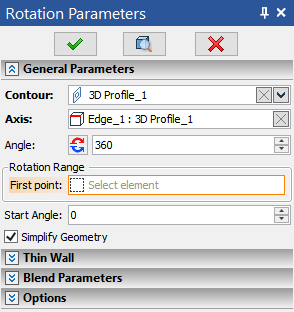
If the command parameters assume the possibility of using variables, then to the right of the value editing field, there is a field that shows the current value if it is set using a variable or expression. If the value of any parameter is set to From document or Default, then the real value of this parameter is displayed to the right of this field.
The title and contents of the window depend on the currently active command and its options. The parameters displayed in the window can be changed by directly entering the necessary value from the keyboard. The current field for entering values can be set by pointing at it with the cursor and pressing ![]() , or using the keyboard. The keyboard shortcut for switching to a particular field of the parameters window is displayed in the hint when you hover the cursor over this field.
, or using the keyboard. The keyboard shortcut for switching to a particular field of the parameters window is displayed in the hint when you hover the cursor over this field.
A non-modal dialogue can be collapsible, i.e. dialog parameter groups can be hidden. If you open a part of a dialog, then this sign is saved for this particular dialog, and the next time you enter this command, the window view will be saved. In the commands for creating 3D elements and operations in the Parameters window, the Finish input, Preview Operation Result and Exit command buttons are available, which work synchronously with the corresponding options in the automenu.
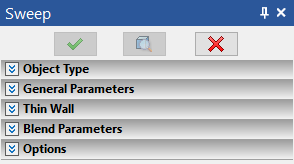
For most options, you can select the display type in the parameters window.
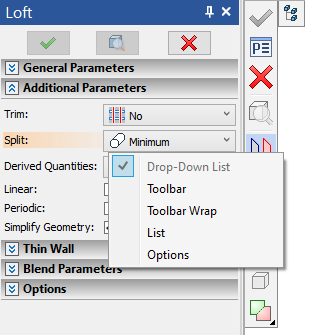
The following types of display options are available:
•Drop-Down List
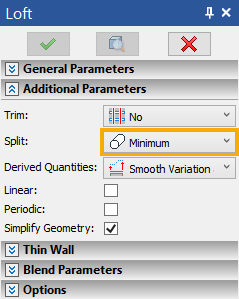
•Toolbar. With this option, during the narrowing of the window, the icons will also be narrowed.
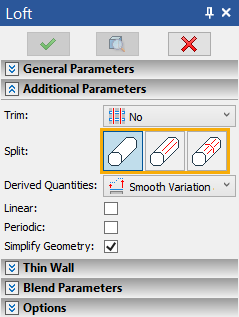
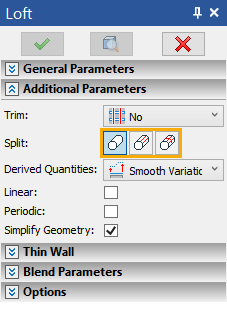
•Toolbar Wrap. With this option, the icons will be moved during the narrowing of the window.
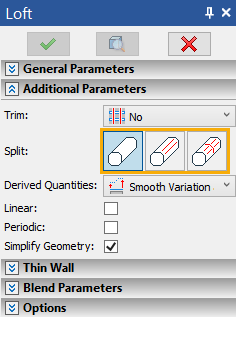
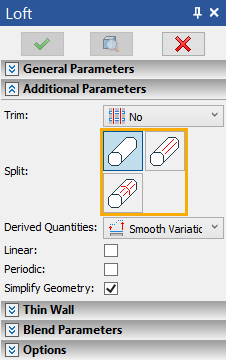
•List
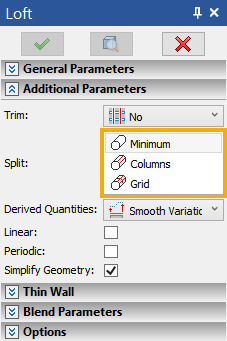
•Options
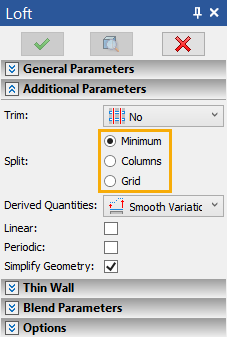
Using window to set command parameters
Most of the T-FLEX CAD commands use the Parameters window to set the parameters of the element or operation being created. However, some of the parameters can only be accessed by calling the option ![]() (<P>). For example, setting the transformation of 3D construction elements and operations.
(<P>). For example, setting the transformation of 3D construction elements and operations.
Using window to set the parameters of the selected objects
When you select several elements of the same or different types, you can edit their parameters using the Parameters window. If the parameters window is disabled (Hide option), then its call is available through the Parameters context menu command if more than one item is selected.
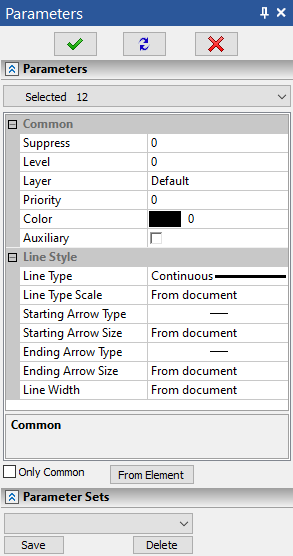
The window displays the number of selected elements and a complete list of the parameters of these elements. When the Only Common checkbox is enabled, only those parameters that are available for all selected elements are placed in the list. The drop-down list at the top of the (Selected) dialog allows you to see what type of items are currently selected. In addition, when you select a specific type of elements in this list, the properties of elements of only this type will be set. The From Element button allows you to select an element on the screen, the property values of which will be used as the current values. The lower drop-down part of the Parameter Sets dialog allows you to save the current set of parameters with a specific name for later use. You can load such a set using the button of the drop-down list, which contains the names of the saved sets. At the top of the dialog document, there are 3 buttons Finish input, Apply Changes and Exit command.
When you use Finish input, the selected properties are applied and the items are deselected.
When you click Apply Changes, the selected properties are applied, but the selection is not canceled.
When you click Exit command, the selection is canceled and the dialog is closed.
Topics in this section: